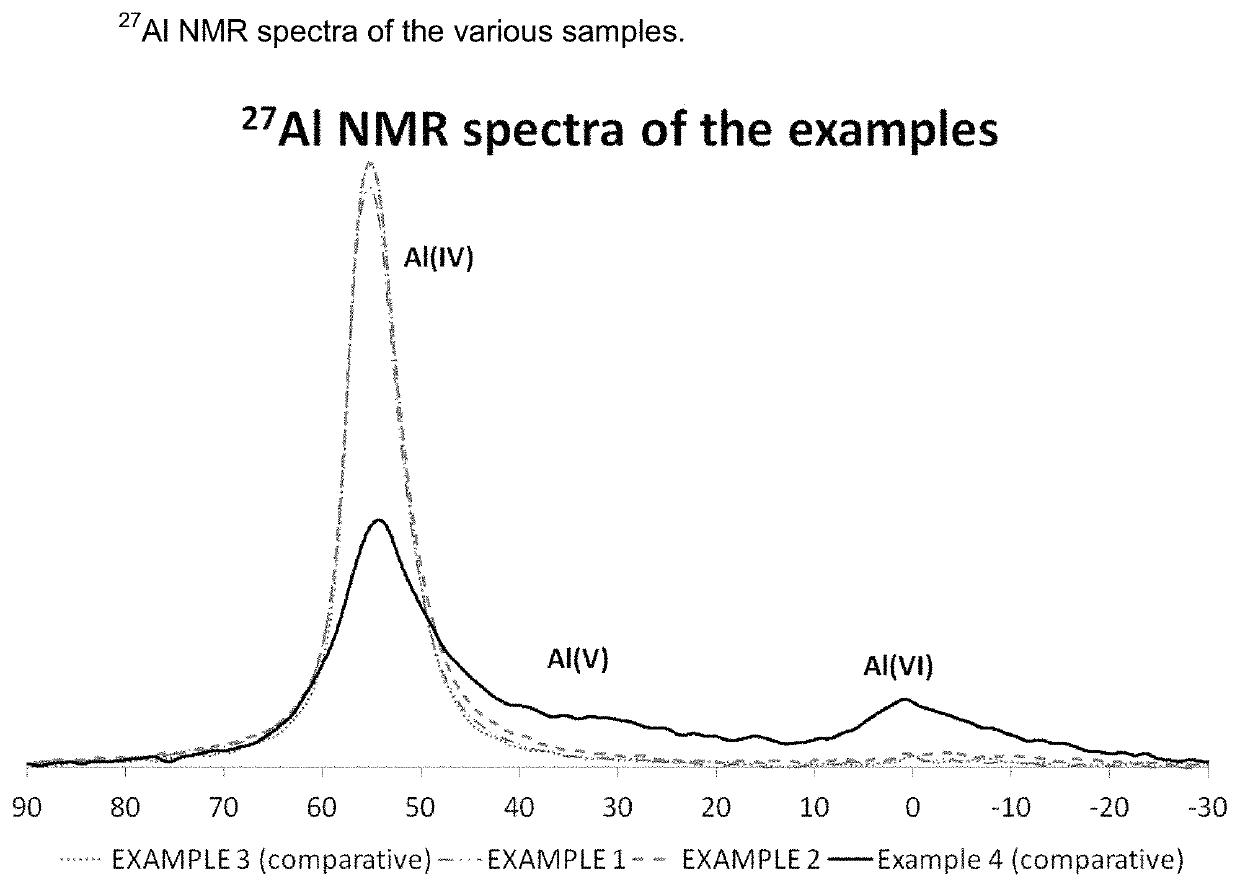Modified crystalline aluminosilicate for dehydration of alcohols
a technology of crystalline aluminosilicate and alcohol, which is applied in the direction of catalyst activation/preparation, hydrocarbon preparation catalysts, physical/chemical process catalysts, etc., can solve the problems of loss of shape selectivity of zeolite framework, increase deactivation rate, and extra framework aluminium, etc., to achieve good to excellent selectivity and easy regenerated
- Summary
- Abstract
- Description
- Claims
- Application Information
AI Technical Summary
Benefits of technology
Problems solved by technology
Method used
Image
Examples
example 1
[0112]10 g of a sample of calcined powder FER55 (CP914 from Zeolyst international) having a Si / Al of 32 and S / W of 1.0 was treated with an aqueous solution of citric acid having a concentration of 0.1M at room temperature. Then, the solution was put in an ultrasonic bath for 30 min or stirred for 30 min in a beaker, filtrated and washed with 5 L of deionized water, dried at 120° C. overnight and calcined at 550° C., 1° C. / min in flow of air (10 NI / h) for 6 h to form a modified crystalline aluminosilicate of FER structure according to the present invention having S / W ratio of 0.95. Isobutanol has been reacted on the catalyst at atmospheric pressure, at temperatures between 100 and 500° C., and with an isobutanol weight hour space velocity (WHSV) from 1.3 to 3.1 h−1. In these operating conditions, starting from 200° C., isobutanol conversion was complete with selectivity to butenes of 99.2%. The ratio of 2-butenes to butenes was 0.75. The results presented in table 1 were obtained wit...
example 2
[0113]10 g of a sample of calcined powder FER55 structure (CP914 from Zeolyst international) having a Si / Al of 32 and S / W of 1.0 was suspended in 200-250 mL of 0.05M aqueous solution of disodium ethylene diamine tetracetic acid salt at room temperature. The suspension was heated at 75° C. for 16 h, filtrated and washed with 10 L of deionized water. The sample was further treated two times with 200 mL of 0.2M of NH4NO3 solution at room temperature for 4 h and washed with at least 2 L of deionized water each time, dried at 120° C. overnight and calcined at 550° C. for 6 h (1° C. / min, in flow of air, 10 NI / h) to form a modified crystalline aluminosilicate of FER structure according to the present invention having a S / W ratio of 0.64. The content of sodium in the modified crystalline aluminosilicate is of 1% wt. Isobutanol has been reacted on the catalyst at atmospheric pressure, at temperatures between 100 and 500° C., and with an isobutanol weight hour space velocity (WHSV) from 1.3 t...
example 3
[0114]10 g of a sample of calcined powder FER55 structure (CP914 from Zeolyst international) having a Si / Al of 32 and S / W of 1.0 was used as comparative catalyst. Isobutanol has been reacted on the catalyst at atmospheric pressure, at temperatures between 100 and 500° C., and with an isobutanol weight hour space velocity (WHSV) from 1.3 to 3.1 h−1. In these operating conditions, starting from 200° C., isobutanol conversion was complete with selectivity to butenes of 98.9%. The ratio of 2-butenes to butene was 0.74. The results presented in table 1 were obtained with a temperature of 200° C., WHSV of 3.1 h−1 at atmospheric pressure.
PUM
| Property | Measurement | Unit |
|---|---|---|
| temperature- | aaaaa | aaaaa |
| temperature | aaaaa | aaaaa |
| molar ratio | aaaaa | aaaaa |
Abstract
Description
Claims
Application Information
 Login to View More
Login to View More - R&D
- Intellectual Property
- Life Sciences
- Materials
- Tech Scout
- Unparalleled Data Quality
- Higher Quality Content
- 60% Fewer Hallucinations
Browse by: Latest US Patents, China's latest patents, Technical Efficacy Thesaurus, Application Domain, Technology Topic, Popular Technical Reports.
© 2025 PatSnap. All rights reserved.Legal|Privacy policy|Modern Slavery Act Transparency Statement|Sitemap|About US| Contact US: help@patsnap.com

